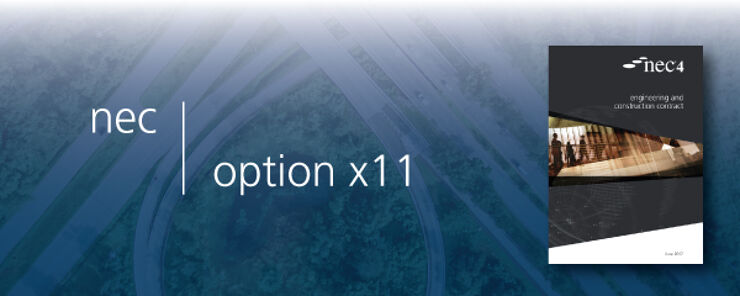
Key Points
- Essential for parties to follow correct termination procedures correctly to minimise liabilities.
- Project manager must receive a valid notification to terminate from either party.
- There are 22 reasons for termination, but client can terminate for any reason if X11 used.
In times of political and economic uncertainty, even the largest contracts can be cancelled and the biggest contractors fail. According to the UK Statistics Authority, construction now has more new insolvencies than any other industry, with 3013 insolvencies in the 12 month period to March 2019.
Furthermore, even the best-planned projects can run into irretrievable difficulty. In all cases it is vital for parties engaged under an NEC4 Engineering and Construction Contract (ECC) to follow the correct procedures for termination to keep their liabilities and costs to a minimum.
Notification
If either party wishes to terminate the contractor’s obligation to provide the works in an NEC4 ECC they must first notify the project manager and the other party giving the reason. The notification should be given separately from other communications (clause 13.7). NEC4 allows the use of a ‘communication system’ (clause 13.2), such as cloud software, and using the means of communication specified in the contract is essential to avoid the notification being invalid. Z clauses may exclude the use of electronic communication for termination so may render a notice made in that way invalid (see Ticket2Final OU v. Wigan Athletic [2015] EWHC 61b).
The project manager has to agree that the reason given complies with the contract before issuing a termination certificate promptly (clause 90.1). This process should provide some protection to the parties from repudiation resulting from invalid termination (see ICI v. Merit Merrell [2017] EWHC 17630).
The project manager is not required to undertake an ‘assessment’, as is necessary for payment and compensation events. This, in theory, should allow the project manager to carry out their duty with little or no delay, ensuring the position of the parties are not held in abeyance However, the contract is silent on the course of action when the project manager thinks the reason given by the terminating party does not comply with the contract. A project manager in this position might wish to remind both parties of their continued obligations until a termination certificate is issued. If a party did not agree with the project manger’s decision, it could challenge their action or inaction through adjudication (option W1/W2).
There are five reasons for termination (R11 to R15, see following section) that require the project manager to first notify the contractor of its default. If not put right within four weeks, the client is then entitled to terminate. This condition precedent must be strictly observed otherwise the attempted termination would constitute repudiation of the contract (see Interserve Construction v. Hitachi [2017] EWHC 2633).
A defaulting subcontractor could constitute a default by the contractor by virtue of clause 26.1. The NEC4 Engineering and Construction Subcontract (ECSC) requires the subcontractor to put right a default within three weeks of the contractor’s notification, allowing the project manager’s notification to the contractor to be managed along the supply chain.
Reasons for termination
A party may terminate for a reason identified in the termination table (clause 90.2). The client’s right to terminate for any reason at will applies only if secondary option X11 has been chosen. This is different to NEC3 ECC, where the client’s contractual right to terminate for any reason is stated in core clause 90.2.
Clause 91 describes 22 reasons for termination. Reasons R1 to R10 are types of insolvency applying to both parties. Before exercising its right to terminate, a party should be encouraged to establish the full facts of the other party’s financial position. Reasons R1 to R10 include arrangements made with creditors and administration, both of which allow a company to remain operating. In these circumstances novation of the contract, which requires the consent of both parties, may be a better solution.
Included within the five contractor defaults (R11 to R15) are the words ‘Substantially failed to comply with its obligations’ (R11). In legal proceedings a court would need to decide if the failure constituted a ‘material breach’ of the contract. Contemplating the right to terminate, the project manager and client should consider the seriousness of the contractor’s failure and its financial impact if not put right (see National Power v. United Gas Co [1998] All ER (D) 321).
The contractor is entitled to terminate if it has not received payment within 13 weeks (R16). If the Housing Grants, Construction and Regeneration Act 1996 applies and non payment is the subject of a pay less notice (clause Y2.3), the project manager will need to decide if non payment was justified and the notice properly served before issuing a termination certificate.
If work is suspended for more than 13 weeks following a project manager’s instruction (clause 34.1), either party may terminate (R18 to R20). The project manager would need to agree that it was ‘substantial work’ that had been stopped. An instruction to stop work is a compensation event (clause 60.1(4)) so, unless the project manager decides the event was due to the contractor’s fault (clause 61.2), assessment of the event should have been progressed within 13 weeks.
Prevention events only allow the client to terminate (R21). A prevention event (clause 19.1) may be a compensation event (clause 60.1(19)) but not a reason for termination if it delays completion by less than 13 weeks. The project manager would therefore need to have made a full assessment of the delay against the accepted programme when deciding to certify termination or assess as a compensation event.
An act of corruption by the contractor (11.2(5)) entitles the client to terminate unless the act was by a subcontractor, and the contractor was not aware or had taken steps to prevent it (R22).
‘A party may terminate for a reason identified in the termination table (clause 90.2). The client’s right to terminate for any reason at will applies only if secondary option X11 has been chosen’
Procedures and payment
The procedures and amounts due (clause 92 and 93) depend on the reason for termination. Once the project manager has issued the termination certificate, procedures must commence immediately (clause 90.3).
The client is entitled to complete the works regardless of the reason for termination (procedure P1). If the client has terminated at will (option X11) or for a reason caused by the contractor (R1 to R15, R18 or R22) procedures P2 and P3 apply. Subcontracts may be assigned (P2) but the client is only permitted to assign the benefit of a subcontract so, if a new contract is required to allow completion of work, negotiation on payment will also be required. P3 allows the client to use equipment owned by the contractor but only to complete the works. The client cannot use equipment hired by the contractor. Under the NEC4 January 2019 amendments, P3 no longer applies to R17 and R20 and is replaced with P4, which requires the contractor to remove equipment.
The project manager assesses the amount due within 13 weeks of issuing the termination certificate (clause 53.1). If the Housing Grants, Construction and Regeneration Act applies, payment becomes due 1 week later (clause Y2.2). The final date for payment will depend on the period stated in the contract data. An interim payment certified before termination may be deferred if its final date for payment is after the date of termination (clause 90.3), subject to the provisions of clause Y2.4.
The amount due on termination is assessed in line with amount A1 and one or more of the amounts A2, A3 and A4. A1 includes an assessment of ‘normal payments’ and depend on which main and secondary options apply. Any sums retained under option X16 and clause 50.5 are repaid. If termination is by the client due to contractor insolvency or default, the amount due includes deduction of a forecast of additional cost to complete the works (A3).
A project manager’s forecast, which has to be concluded in 13 weeks, carries a different risk to both parties compared to an assessment based on actual costs. If the client has terminated at will, or the contractor has terminated due to client insolvency, non payment or default, the contractor is entitled to be paid its fee percentage applied to the value of the remaining work (A4). This has the effect of reimbursing the contractor its overheads and loss of profit.
Rights and liabilities after termination
Termination is of the contractor’s obligation to provide the works (clause 90.1). This approach is consistent with the common law doctrine ‘the contract survives termination’, meaning any rights and liabilities accrued under the contract remain. For example, the contractor will be liable for its defects. In Liberty Mercian v. Cuddy Civil Engineering [2013] EWHC 2688, the court held the right to a bond or guarantee was an ancillary right that survived termination and was not part of the contractor’s obligation to provide the works.
Conclusion
The process for termination as described in NEC4 ECC may seem straightforward, but in practice it is complex and potentially contentious. Faced with the prospect of termination, clients, project managers and contractors should all seek competent legal advice. They should always follow the contract and in particular any amendments.



